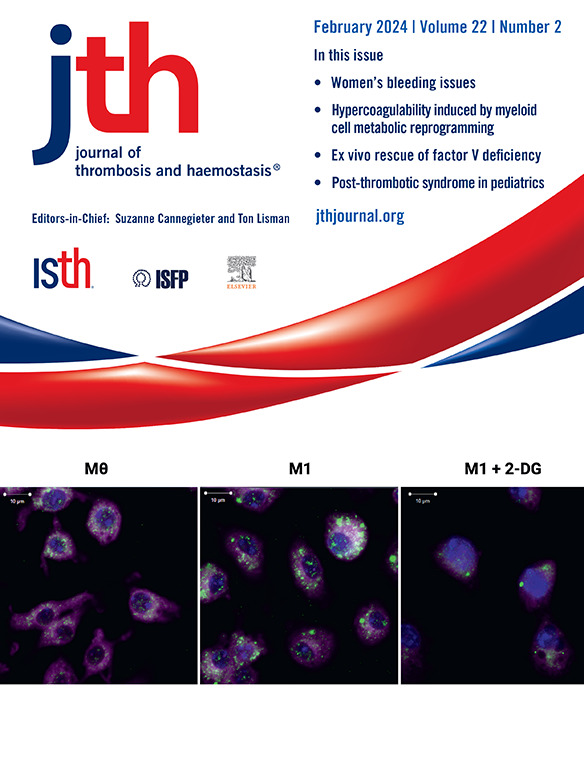Association of fibrinogen αE, fibrinogen γ', and sialylated fibrinogen with development of ischemic stroke in patients with recently diagnosed type 2 diabetes
IF 5.5
2区 医学
Q1 HEMATOLOGY
引用次数: 0
Abstract
Background
Stroke is a major cause of death globally, especially in type 2 diabetes (T2D) patients. Fibrinogen is known to predict stroke risk, but fibrinogen is a highly variable protein and we hypothesized that fibrinogen variants can improve stroke prediction.
Objectives
We aimed to investigate the association of total fibrinogen and fibrinogen variants with risk of ischemic stroke in T2D patients.
Methods
In a nested case-control study with a median follow-up of 4.1 years, we included 144 T2D patients with ischemic stroke (cases) and 144 matched T2D patients without ischemic stroke (controls). We measured total fibrinogen, absolute, and relative levels of 3 fibrinogen variants (fibrinogen αE, fibrinogen γ′, and sialylated fibrinogen) and compared levels between cases and controls. We used logistic regression to determine the association with stroke risk.
Results
Total fibrinogen and absolute levels of fibrinogen αE, fibrinogen γ′, and sialylated fibrinogen were higher in stroke cases than controls. Absolute levels of fibrinogen positively associated with risk of stroke for total fibrinogen (highest vs lowest tertile; adjusted odds ratio (OR), 1.9 [95% CI, 0.9-4.2]), fibrinogen γ′ (OR, 1.8 [0.8-3.8]), and sialylated fibrinogen (OR, 2.5 [1.1-5.8]). Relative levels of fibrinogen variants did not convincingly associate with stroke risk.
Conclusion
Patients with T2D who developed stroke had increased levels of total fibrinogen, fibrinogen αE, fibrinogen γ′, and sialylated fibrinogen compared with T2D controls. Total fibrinogen and absolute, but not relative, levels of fibrinogen γ′ and sialylated fibrinogen prospectively associated with a 2-fold increased risk of ischemic stroke.
纤维蛋白原 αE、纤维蛋白原 γ 和糖基化纤维蛋白原与新近确诊的 2 型糖尿病患者发生缺血性中风的关系。
背景:卒中是全球死亡的主要原因,尤其是2型糖尿病(T2D)患者。已知纤维蛋白原可以预测中风风险,但纤维蛋白原是一种高度可变的蛋白质,我们假设纤维蛋白原变异可以改善中风预测。目的:探讨总纤维蛋白原和纤维蛋白原变异与T2D患者缺血性卒中风险的关系。方法:在一项中位随访4.1年的巢式病例对照研究中,我们纳入了144例合并缺血性卒中的T2D患者(病例)和144例匹配的无缺血性卒中的T2D患者(对照组)。我们测量了三种纤维蛋白原变体(纤维蛋白原αE、纤维蛋白原γ´和唾液化纤维蛋白原)的总纤维蛋白原、绝对和相对水平,并比较了病例和对照组之间的水平。我们使用逻辑回归来确定与中风风险的关系。结果:脑卒中患者总纤维蛋白原αE、纤维蛋白原γ′、唾液化纤维蛋白原含量均高于对照组。纤维蛋白原绝对水平与卒中风险呈正相关,无论是总纤维蛋白原水平(最高与最低);校正优势比(OR) 1.9 (95% CI 0.9-4.2),纤维蛋白原γ (OR 1.8(0.8-3.8))和唾液化纤维蛋白原(OR 2.5(1.1-5.8))。纤维蛋白原变异的相对水平与中风风险没有令人信服的联系。结论:与T2D对照组相比,发生卒中的T2D患者总纤维蛋白原、纤维蛋白原αE、纤维蛋白原γ´和唾液化纤维蛋白原水平升高。总纤维蛋白原和绝对(而非相对)纤维蛋白原γ和唾液化纤维蛋白原水平与缺血性卒中风险增加2倍有前瞻性关联。
本文章由计算机程序翻译,如有差异,请以英文原文为准。
求助全文
约1分钟内获得全文
求助全文
来源期刊
CiteScore
24.30
自引率
3.80%
发文量
321
审稿时长
1 months
期刊介绍:
The Journal of Thrombosis and Haemostasis (JTH) serves as the official journal of the International Society on Thrombosis and Haemostasis. It is dedicated to advancing science related to thrombosis, bleeding disorders, and vascular biology through the dissemination and exchange of information and ideas within the global research community.
Types of Publications:
The journal publishes a variety of content, including:
Original research reports
State-of-the-art reviews
Brief reports
Case reports
Invited commentaries on publications in the Journal
Forum articles
Correspondence
Announcements
Scope of Contributions:
Editors invite contributions from both fundamental and clinical domains. These include:
Basic manuscripts on blood coagulation and fibrinolysis
Studies on proteins and reactions related to thrombosis and haemostasis
Research on blood platelets and their interactions with other biological systems, such as the vessel wall, blood cells, and invading organisms
Clinical manuscripts covering various topics including venous thrombosis, arterial disease, hemophilia, bleeding disorders, and platelet diseases
Clinical manuscripts may encompass etiology, diagnostics, prognosis, prevention, and treatment strategies.

 求助内容:
求助内容: 应助结果提醒方式:
应助结果提醒方式:


